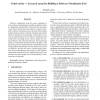Free Online Productivity Tools
i2Speak
i2Symbol
i2OCR
iTex2Img
iWeb2Print
iWeb2Shot
i2Type
iPdf2Split
iPdf2Merge
i2Bopomofo
i2Arabic
i2Style
i2Image
i2PDF
iLatex2Rtf
Sci2ools
CSMR
2003
IEEE
2003
IEEE
CodeCrawler - Lessons Learned in Building a Software Visualization Tool
Software visualization tools face many challenges in terms of their implementation, including scalability, usability, adaptability, and durability. Such tools, like many other research tools, tend to have a short life cycle and are vulnerable to software evolution processes because of the complex problem domain and the constantly changing requirements which are dictated by research goals. In this paper we discuss the implementation of the software visualization tool CodeCrawler according to five criteria, namely the overall architecture, the internal architecture, the visualization engine, the metamodel and the interactive facilities. This discussion generates implementation recommendations and design guidelines that hold for our tool and the class of tools its stands for. We then also extract common design guidelines and recommendations that apply for other software visualization and general reverse engineering tools as well, and hope that these insights can be used fruitfully by ot...
CSMR 2003 | Design Guidelines | Software Engineering | Software Visualization Tool | Visualization Tool Codecrawler |
| Added | 04 Jul 2010 |
| Updated | 04 Jul 2010 |
| Type | Conference |
| Year | 2003 |
| Where | CSMR |
| Authors | Michele Lanza |
Comments (0)

